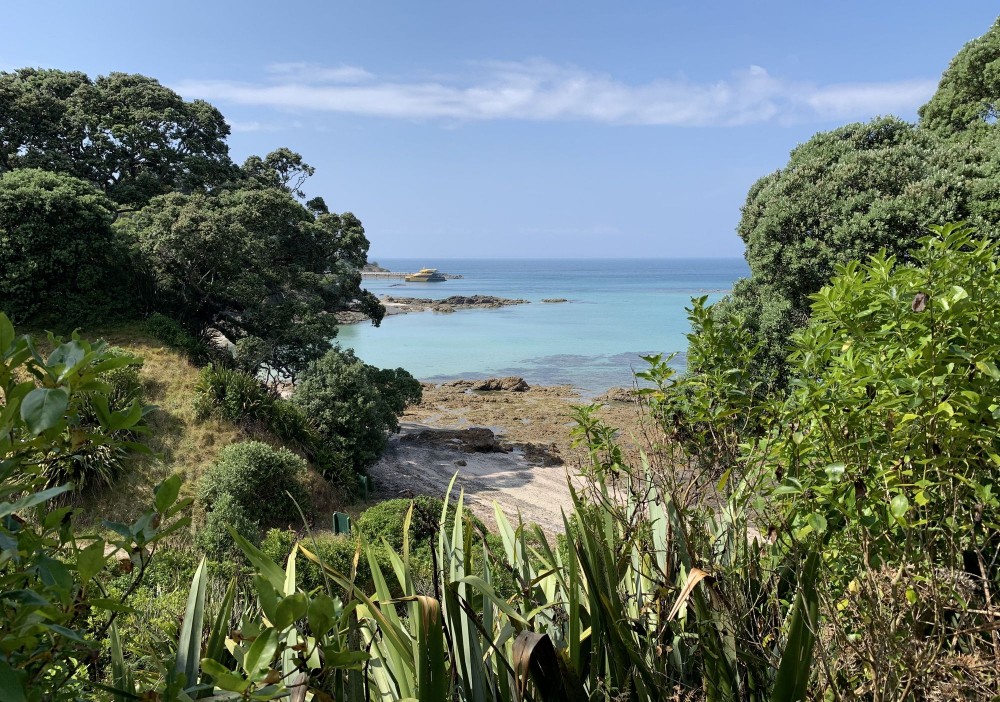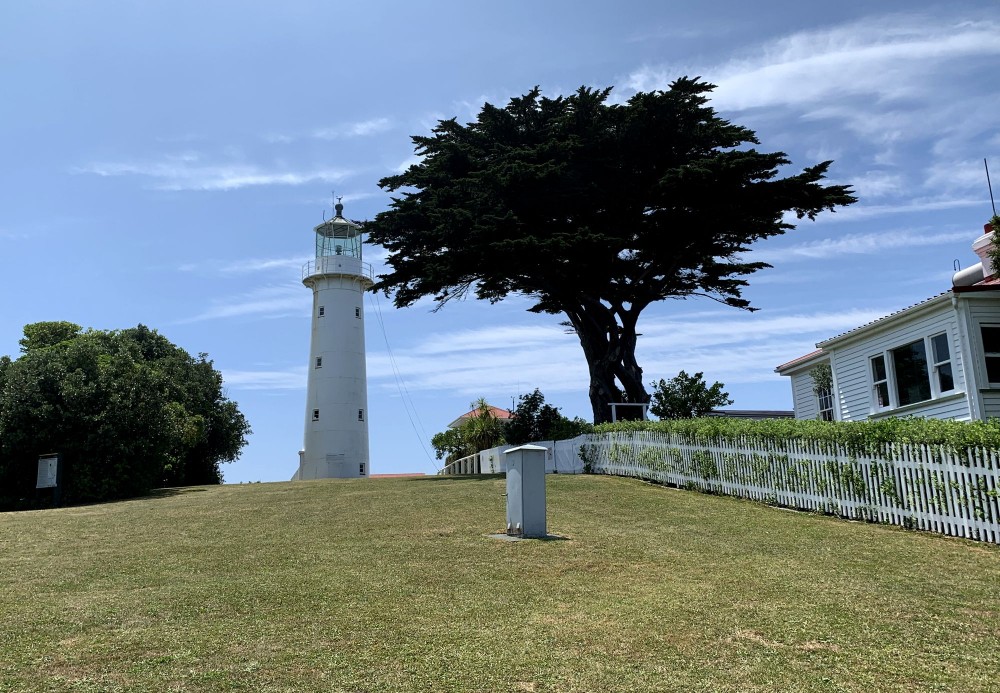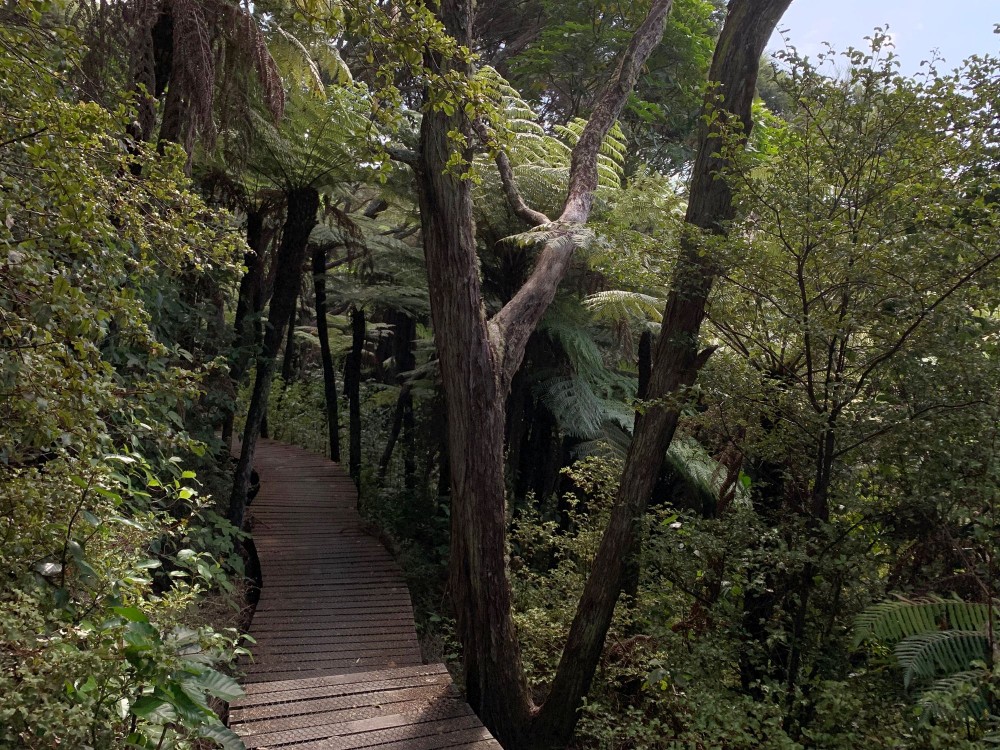Tiritiri Matangi Island
30 January 2019
10:30 to 15:30
Tirtiri Matangi (or short 'Tiri') is truely a wonderful place to go birding and see an abundance of endemic birds up-close! It should not be missed.
You can make a one day trip from Auckland or stay overnight on the island.
Visited Sites
General Travelling Information
You can book a cheap guided walk when booking your ferry (or maybe join spontaneously if there is still space). But you're also free to walk the island by yourself and enjoy the birds at your own pace.
Recommended Literature
Tiritiri Matangi's great website (incl. map) is very informative and you will find all answers to your questions. On the ferry or at the visitor center you can also buy a map / leaflet, supporting the island.
General birding books:
- Scofield & Stephenson 2013 Birds of New Zealand - A Photographic Guide
Great and uptodate book with lots of quality pictures. - Heather & Robertson 2015 The Field Guide to the Birds of New Zealand
Also available as a Hand Guide which contains only the plates and is considerably lighter; I prefer the Field Guide with all the additional species information
If you want to buy a book after you arrive, maybe check out Whitcoulls at Little High Street Arcade (Auckland). But if you want to be on the safe side, better order before or bring from home, since I didn't find too many bookstores that are equipped with the 'right' books.
The online resources at New Zealand Birds Online are amazing and at the end you'll wish you'd have that for every country that you're birding in...
For additional birding questions and most recent infos I recommend the forum at BirdingNZ.net
Tiritiri Matangi Island
Tiritiri Matangi is a small island about 30km from Auckland. This open wildlife sanctuary is one of New Zealand's most important and outstanding conservation projects. There are 20 endemics among the ~70 species of birds that you can find on and around the island. All mammalian predators were eradicated and weeds are controlled, so please check your luggage carefully for unwanted guests.
Most of the island's vegetation had been cut down, but in 1984 a big tree planting effort ensured a vegetation cover of 60% nowadays. It is about 2.7km long and 1km wide, and is accessable through a range of good tracks.
The island is run by the Department of Conservation (DOC) and the Supporters of Tiritiri Matangi and you should defintiely first check out their website.
Target species
-
 Little Spotted Kiwi
Apteryx owenii
Little Spotted Kiwi
Apteryx owenii
This kiwi species survived only on islands and is very slowly brought back to the mainland after a great conservation success on e.g. Tiri or Kapiti Island. You will have to stay overnight and walk the tracks at night. And as with all kiwis: be patient and lucky.
-
 Brown Teal
Anas chlorotis
Brown Teal
Anas chlorotis
Once widespread, this little duck is now very localised. On Tiri you can spot them e.g. around the bunkhouse / lighthouse area or on small ponds along the East Coast Track.
-
 South Island Takahe
Porphyrio hochstetteri
South Island Takahe
Porphyrio hochstetteri
A bird once considered extinct and a great conservation story, Tiri is one of the few places where you can still see Takahe. A group usually likes to hang around the lighthouse area at the visitor center and is a very trusting bunch.
-
 Whitehead
Mohoua albicilla
Whitehead
Mohoua albicilla
Very common all over the island. On the mainland only in the southern parts of the North Island.
-
 North Island Kokako
Callaeas wilsoni
North Island Kokako
Callaeas wilsoni
Although there are a few places left to see this species on the mainland, it is not easy to see. It's melancholic calls can be readily heard on the isand, and with some patience you will also be able to spot one of the ~20 birds on Tiri. On their website you can find uptodate information on the individuals and where their territories are.
-
 North Island Saddleback
Philesturnus rufusater
North Island Saddleback
Philesturnus rufusater
In the 1950s only one population was left on a single island. Thanks to conservation and translocations the populations have been rising constantly and it is a very common bird on Tiri.
-
 Stitchbird
Notiomystis cincta
Stitchbird
Notiomystis cincta
The stitchbird (or Hihi) was endemic to the North Island and survived only on Little Barrier Island. Thanks to a good breeding success in the last 20 years, it is now also established at some predator-free islands (and 2 mainland spots). Tiri is certainly one of the best places to observe this cool species. Try the Kawerau Track and from there the Ridge Track to the lighthouse and keep an eye out especially around the feeding stations.
-
 New Zealand Fernbird
Poodytes punctatus
New Zealand Fernbird
Poodytes punctatus
Not rare on the mainland (although numbers are decreasing), but often very hard to observe due to its secretive habits. After introduction to Tiri in 2001 numbers have increased strongly and this endemic can be heard in many habitats. Good places (among others) are on the Ridge Track. Listen to its call and be patient until the bird either climbs up in the vegetation or crawls over the ground in an almost mouse-like fashion.
-
 Red-crowned Parakeet
Cyanoramphus novaezelandiae
Red-crowned Parakeet
Cyanoramphus novaezelandiae
A rare parakeet that is doing very well on Tiri. Keep your eyes open as they are tiny and can easily be overlooked in the vegetation. A good place is at the end of Hobbs Beach when the track leaves the beach.
How to get there
Take a Fullers ferry either from Auckland Harbour or join the ferry at its second stop in Gulf Harbour. The prize is the same and Gulf Harbour offers the advantage of free parking, but the ferry from Auckland Harbour offers a 20 min longer ride. If leaving from Auckland Harbour you can park your car in a close-by parking lot like the Downtown Carpark.
The ferry leaves Auckland at 9am, arriving on Tiri at around 10:15h. The return ferry leaves at 15:30h sharp!! Don't miss it, otherwise you'll have to order a water taxi.
When planning to stay overnight on the island, be advised that the ferry does NOT run on Monday and Tuesday.
From the ferry (especially after Gulf Harbour) keep an eye out for seabirds. Depending on the time of year, a few species are possible like Fluttering or Buller's Shearwater, but also White-faced Storm Petrel.
Facilities & accommodation
Staying overnight on Tiri is definitely recommended (especially if you want a chance at finding Little spotted kiwi). Your accomodation is a simple but comfortable bunkhouse. You need to arrange your own food and sleeping bag etc, so plan accordingly. The bunkouse does not offer many places and is often booked out months ahead, so it is well advised to book as early as possible. At night you might not only hear/see kiwi or brown teal, but (depending on the season) hear or see seabirds flying around the island like grey-faced petrel, common diving petrel or fluttering shearwater.
You can book the bunkhouse with DOC.
Other wildlife observed
Especially around the Kawerau track look for eels in the stream when you're out at night.
If you're lucky you might also spot one of the tuataras that have been established on the island in 2003. Tuataras are generally night active, but can be seen sun basking during the day at their burrows. A good place is supposed to be along the Hobbs Beach Track.
Besides the more common weta (that you can spot in the wodden 'weta hotels' along the tracks), you might also get lucky to find a giant weta / Wetapunga which were introduced in 2010. New Zealand's largest insect is active at night, so don't forget them when you go for kiwis.
In addition, you can also find rare skinks or geckos and of course dolphins from the ferry.
Species List
-
 Brown Quail
Synoicus ypsilophorus
details
sounds
Brown Quail
Synoicus ypsilophorus
details
sounds
-
 New Zealand Pigeon
Hemiphaga novaeseelandiae
details
sounds
New Zealand Pigeon
Hemiphaga novaeseelandiae
details
sounds
-
Tiritiri Matangi Island
2019-01-30 5 ind.
-
-
 South Island Takahe
Porphyrio hochstetteri
details
sounds
South Island Takahe
Porphyrio hochstetteri
details
sounds
-
 Australasian Swamphen
Porphyrio melanotus
details
sounds
Australasian Swamphen
Porphyrio melanotus
details
sounds
-
 Variable Oystercatcher
Haematopus unicolor
details
sounds
Variable Oystercatcher
Haematopus unicolor
details
sounds
-
Tiritiri Matangi Island
2019-01-30 8 ind.
-
-
 Red-breasted Dotterel
Anarhynchus obscurus
details
sounds
Red-breasted Dotterel
Anarhynchus obscurus
details
sounds
-
 Kelp Gull
Larus dominicanus
details
sounds
Kelp Gull
Larus dominicanus
details
sounds
-
Tiritiri Matangi Island
2019-01-30 3 ind.
-
-
 Little Penguin
Eudyptula minor
details
sounds
Little Penguin
Eudyptula minor
details
sounds
-
Tiritiri Matangi Island
in the see-through boxes along Hobbs Beach Track
2019-01-30 2 ind.
-
-
 Buller's Shearwater
Ardenna bulleri
details
sounds
Buller's Shearwater
Ardenna bulleri
details
sounds
-
 Swamp Harrier
Circus approximans
details
sounds
Swamp Harrier
Circus approximans
details
sounds
-
Tiritiri Matangi Island
2019-01-30 1 ind.
-
-
 Sacred Kingfisher
Todiramphus sanctus
details
sounds
Sacred Kingfisher
Todiramphus sanctus
details
sounds
-
Tiritiri Matangi Island
2019-01-30 1 ind.
-
-
 Red-crowned Parakeet
Cyanoramphus novaezelandiae
details
sounds
Red-crowned Parakeet
Cyanoramphus novaezelandiae
details
sounds
-
Tiritiri Matangi Island
2019-01-30 4 ind.
-
-
 Rifleman
Acanthisitta chloris
details
sounds
Rifleman
Acanthisitta chloris
details
sounds
-
Tiritiri Matangi Island
2019-01-30 2 ind.
-
-
 Tui
Prosthemadera novaeseelandiae
details
sounds
Tui
Prosthemadera novaeseelandiae
details
sounds
-
Tiritiri Matangi Island
2019-01-30 20 ind.
-
-
 New Zealand Bellbird
Anthornis melanura
details
sounds
New Zealand Bellbird
Anthornis melanura
details
sounds
-
 Gray Gerygone
Gerygone igata
details
sounds
Gray Gerygone
Gerygone igata
details
sounds
-
Tiritiri Matangi Island
2019-01-30 2 ind.
-
-
 Whitehead
Mohoua albicilla
details
sounds
Whitehead
Mohoua albicilla
details
sounds
-
 New Zealand Fantail
Rhipidura fuliginosa
details
sounds
New Zealand Fantail
Rhipidura fuliginosa
details
sounds
-
Tiritiri Matangi Island
2019-01-30 11 ind.
-
-
 North Island Kokako
Callaeas wilsoni
details
sounds
North Island Kokako
Callaeas wilsoni
details
sounds
-
 North Island Saddleback
Philesturnus rufusater
details
sounds
North Island Saddleback
Philesturnus rufusater
details
sounds
-
 Stitchbird
Notiomystis cincta
details
sounds
Stitchbird
Notiomystis cincta
details
sounds
-
 North Island Robin
Petroica longipes
details
sounds
North Island Robin
Petroica longipes
details
sounds
-
 New Zealand Fernbird
Poodytes punctatus
details
sounds
New Zealand Fernbird
Poodytes punctatus
details
sounds
-
 Welcome Swallow
Hirundo neoxena
details
sounds
Welcome Swallow
Hirundo neoxena
details
sounds
-
Tiritiri Matangi Island
2019-01-30 20 ind.
-
-
 Common Myna
Acridotheres tristis
details
sounds
Common Myna
Acridotheres tristis
details
sounds
-
Tiritiri Matangi Island (Introduced)
2019-01-30 3 ind.
-
-
 Song Thrush
Turdus philomelos
details
sounds
Song Thrush
Turdus philomelos
details
sounds
-
Tiritiri Matangi Island (Introduced)
2019-01-30 1 ind.
-
-
 Eurasian Blackbird
Turdus merula
details
sounds
Eurasian Blackbird
Turdus merula
details
sounds
-
Tiritiri Matangi Island (Introduced)
2019-01-30 4 ind.
-
-
 House Sparrow
Passer domesticus
details
sounds
House Sparrow
Passer domesticus
details
sounds
-
Tiritiri Matangi Island (Introduced)
2019-01-30 10 ind.
-
Last updated: 27 February 2019


















